AI Automation in Healthcare: From Hype to Real-World Applications
The healthcare industry stands at a pivotal moment where artificial intelligence is transitioning from experimental technology to essential infrastructure. While headlines often focus on futuristic promises of AI replacing doctors or achieving perfect diagnoses, the reality is both more nuanced and more immediately impactful. Today’s AI automation in healthcare is quietly revolutionizing patient care, streamlining operations, and enhancing medical decision-making in ways that are tangible, measurable, and increasingly indispensable. The convergence of AI and automation in healthcare has created unprecedented opportunities for the automation in healthcare industry to transform traditional care delivery models.
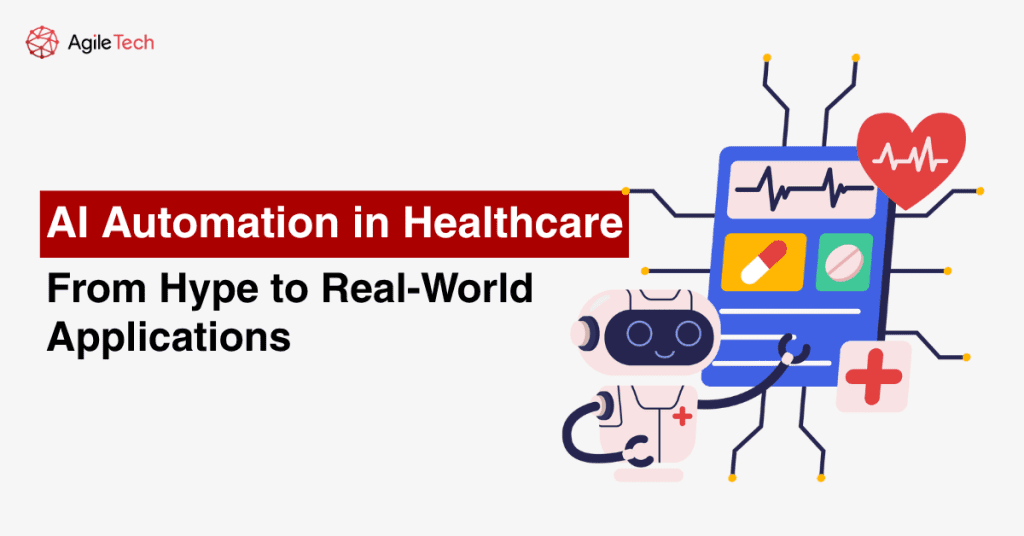
1. What Is AI Automation in Healthcare?
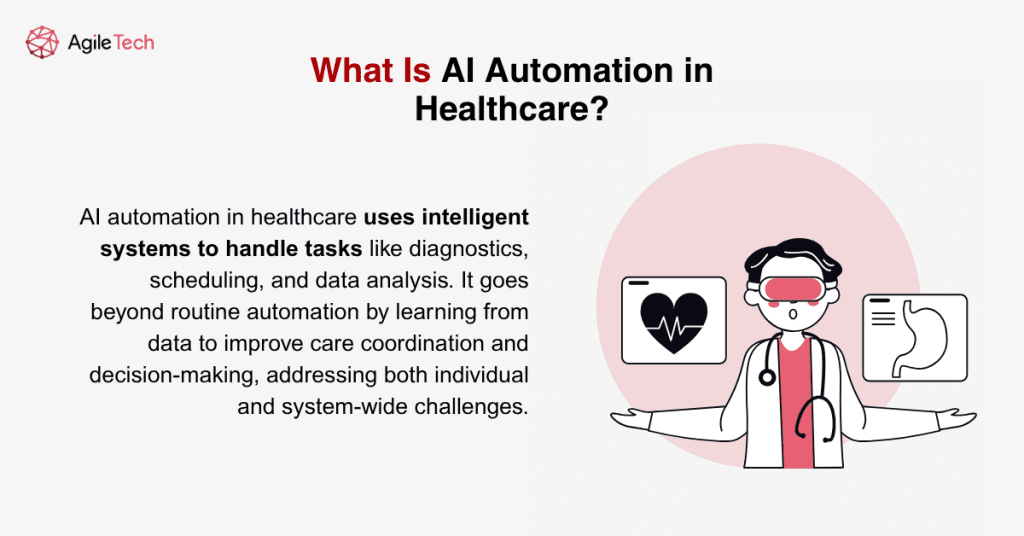
AI automation in healthcare refers to the deployment of artificial intelligence systems to perform tasks traditionally requiring human intervention, from analyzing medical images to managing patient scheduling. Unlike simple digitization, automation in healthcare involves systems that can learn, adapt, and make decisions based on complex data patterns. This encompasses robotic process automation in healthcare for routine administrative tasks, intelligent clinical decision support, and sophisticated diagnostic tools.
This technology encompasses machine learning algorithms that can identify patterns in patient data, natural language processing systems that can interpret medical records, computer vision applications that analyze medical imaging, and robotic process automation that handles administrative workflows. The key differentiator is not just the automation of routine tasks, but the intelligent processing of information that enables healthcare providers to make better, faster decisions.
The scope extends beyond individual tools to integrated systems that can coordinate care across multiple touchpoints. Modern automation in healthcare platforms can simultaneously monitor patient vitals, flag potential complications, schedule follow-up appointments, and alert appropriate medical staff—all while learning from each interaction to improve future performance. This comprehensive approach to AI and automation in healthcare demonstrates the technology’s potential to address systemic challenges rather than isolated problems.
2. Current Market Overview
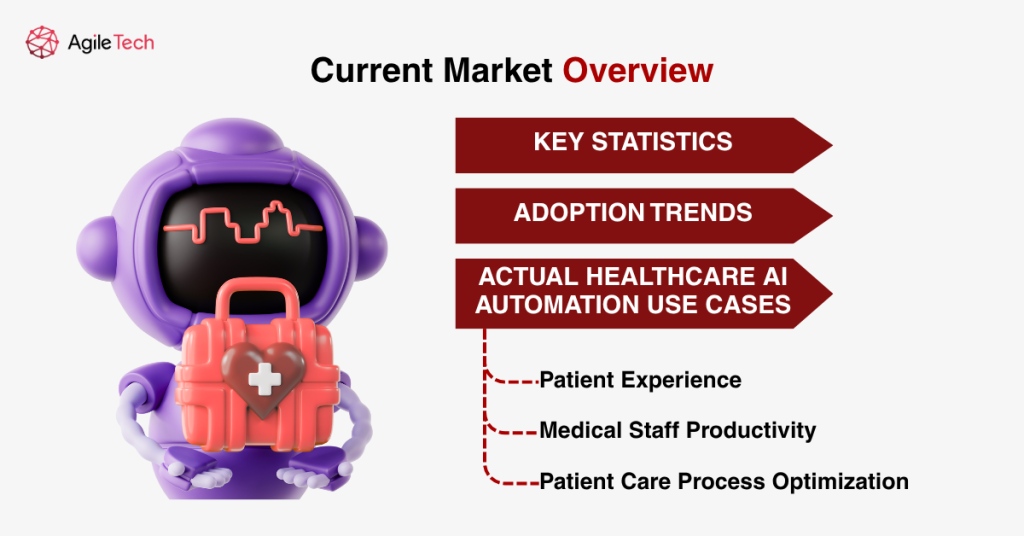
2.1. Key Statistics
The global healthcare AI market has experienced explosive growth, reaching approximately $15.1 billion in 2024 and projected to exceed $102 billion by 2028. This represents a compound annual growth rate of nearly 37%, making it one of the fastest-growing segments in both healthcare and technology sectors.
Investment patterns reveal where the most promising applications lie. Diagnostic imaging AI has attracted over $2.5 billion in funding since 2020, while drug discovery platforms have secured approximately $1.8 billion. Administrative automation tools, though less glamorous, have seen steady investment of around $800 million annually, reflecting their immediate practical value.
Hospital adoption rates vary significantly by application type. Electronic health record integration with AI tools has reached 68% among major hospital systems, while specialized diagnostic AI tools are deployed in approximately 35% of healthcare facilities. Rural and smaller healthcare providers lag significantly, with adoption rates around 15-20% for most AI applications.
The geographic distribution shows North America leading with 45% of global healthcare AI implementations, followed by Europe at 28% and Asia-Pacific at 22%. However, growth rates are highest in emerging markets, where healthcare infrastructure gaps create opportunities for leapfrog adoption of AI-enabled solutions.
Read more: Cost of implementing ai in healthcare
2.2. Adoption Trends
Healthcare organizations are prioritizing AI automation solutions that address immediate operational challenges rather than pursuing cutting-edge applications with uncertain returns. The most common entry point is business process automation in healthcare, with 78% of healthcare systems implementing AI-powered scheduling, billing, or patient communication tools as their first AI initiative.
Integration complexity remains a significant barrier, with 64% of healthcare IT leaders citing interoperability challenges as their primary concern. Successfully deployed systems typically start with standalone applications before gradually integrating with existing healthcare information systems.
Staff acceptance varies dramatically by application type. Clinical decision support tools that augment rather than replace human judgment see adoption rates above 80% among clinicians, while fully automated diagnostic tools face more resistance, with acceptance rates around 45% in primary care settings.
The COVID-19 pandemic accelerated adoption timelines by an estimated 2-3 years, particularly for telehealth integration, patient monitoring systems, and predictive analytics for resource management. This crisis-driven adoption created a foundation for more sophisticated AI automation in healthcare implementations, with workflow automation in healthcare becoming a critical component of pandemic response strategies.
2.3. Actual Healthcare AI Automation Use Cases
Patient Experience
Automation in healthcare is fundamentally reshaping how patients interact with healthcare systems. Intelligent chatbots now handle approximately 40% of initial patient inquiries, providing 24/7 availability for appointment scheduling, symptom checking, and basic health information. These systems can process natural language queries, understand context, and escalate complex cases to human staff when necessary.
Personalized patient communication represents another significant application. AI systems analyze patient preferences, medical history, and communication patterns to customize appointment reminders, treatment instructions, and health education materials. This personalization has improved appointment attendance rates by 23% and medication adherence by 18% in pilot programs.
Predictive patient flow management uses AI to anticipate peak demand periods, optimize staffing levels, and reduce wait times. Emergency departments using these systems report average wait time reductions of 35 minutes and improved patient satisfaction scores.
Medical Staff Productivity
Documentation automation addresses one of healthcare’s most persistent productivity drains. AI-powered clinical documentation systems can generate structured notes from physician-patient conversations, reducing documentation time by up to 60%. These robotic process automation in healthcare systems understands medical terminology, extracts relevant information, and formats notes according to regulatory requirements.
Clinical decision support systems provide real-time recommendations based on patient data, treatment guidelines, and current research. These tools don’t replace clinical judgment but enhance it by flagging potential drug interactions, suggesting alternative treatments, and highlighting relevant diagnostic considerations. Emergency departments report 28% faster diagnosis times when using comprehensive clinical decision support systems.
Automated workflow coordination ensures that test results reach the right clinicians at the right time, follow-up appointments are scheduled appropriately, and care team members are notified of status changes. This workflow automation in healthcare reduces communication delays by an average of 45 minutes per patient case, demonstrating the practical impact of AI and automation in healthcare operations.
Patient Care Process Optimization
Predictive analytics identify patients at risk of complications, readmissions, or deterioration before clinical symptoms become apparent. These automation in healthcare industry solutions analyze patterns in vital signs, laboratory results, and patient behavior to generate early warning scores. Hospitals using these systems report 20% reductions in unexpected intensive care unit transfers and 15% decreases in 30-day readmission rates.
Treatment pathway optimization uses AI to analyze successful treatment patterns and suggest personalized care plans. Cancer treatment centers using these systems report improved treatment response rates and reduced time to optimal therapy selection.
Resource allocation optimization ensures that equipment, staff, and facilities are deployed efficiently. AI systems can predict demand for specific services, optimize surgery scheduling to maximize operating room utilization, and coordinate discharge planning to manage bed availability.
3. Key Applications of AI Automation in Healthcare
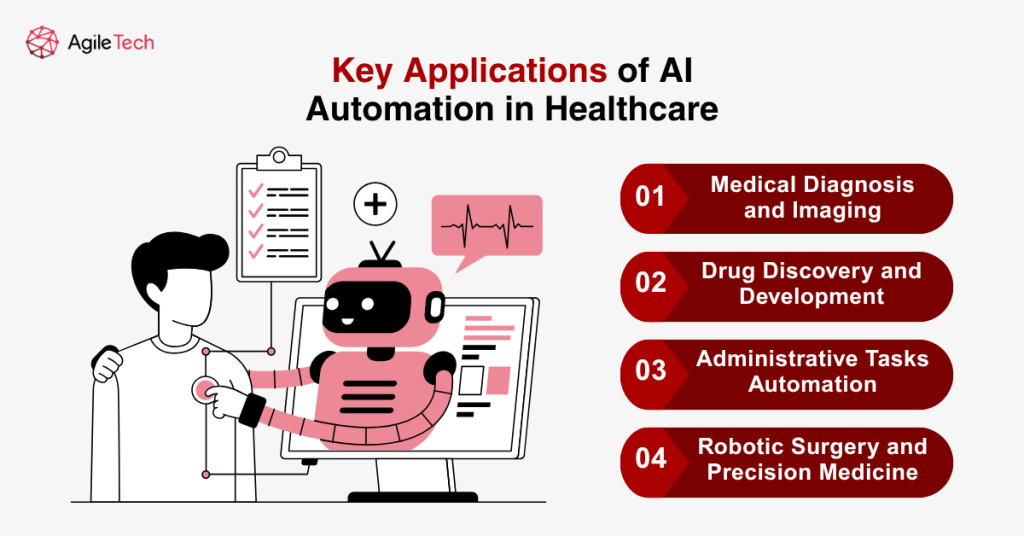
3.1. Medical Diagnosis and Imaging
Medical imaging represents the most mature application of AI automation in healthcare, with FDA-approved systems now deployed across thousands of healthcare facilities. Radiology AI can detect early-stage cancers, identify fractures, and flag urgent cases for immediate attention with accuracy rates that meet or exceed human radiologist performance in specific applications.
Pathology AI systems analyze tissue samples to identify cancer cells, grade tumors, and predict treatment responses. These systems process images at superhuman speed while maintaining consistent accuracy across thousands of samples. Digital pathology workflows integrated with AI reduce diagnosis turnaround times from days to hours in many cases.
Cardiology applications include automated ECG interpretation, echocardiogram analysis, and cardiac catheterization guidance. AI systems can detect subtle rhythm abnormalities, measure cardiac function parameters, and identify coronary artery disease with high precision. Emergency departments using automated ECG analysis report 40% faster identification of heart attacks.
Ophthalmology AI systems screen for diabetic retinopathy, glaucoma, and age-related macular degeneration using smartphone-based cameras or specialized imaging equipment. These tools enable screening in primary care settings and remote locations where specialist access is limited.
The integration of AI with real-time imaging during procedures represents an emerging frontier in automation in healthcare. AI-guided ultrasound helps non-specialist clinicians obtain diagnostic-quality images, while surgical navigation systems provide real-time guidance during complex procedures, showcasing the evolution of AI and automation in healthcare toward more sophisticated applications.
3.2. Drug Discovery and Development
AI automation is compressing drug discovery timelines from decades to years by identifying promising compounds, predicting drug interactions, and optimizing clinical trial design. Machine learning algorithms analyze molecular structures to predict drug efficacy and safety profiles before expensive laboratory testing begins.
Target identification uses AI to analyze genetic data, protein structures, and disease pathways to identify new therapeutic targets. This approach has led to the discovery of novel drug targets for Alzheimer’s disease, cancer, and rare genetic disorders that would have been nearly impossible to identify through traditional methods.
Clinical trial optimization employs AI to identify suitable patient populations, predict enrollment challenges, and design more efficient study protocols. AI systems can analyze electronic health records to identify patients who meet complex inclusion criteria, reducing recruitment timelines by months.
Drug repurposing applications use AI to identify new uses for existing medications by analyzing molecular mechanisms, patient data, and treatment outcomes. This approach significantly reduces development costs and regulatory timelines since safety profiles are already established.
Personalized medicine development leverages AI to identify patient subgroups most likely to respond to specific treatments. These insights enable the development of targeted therapies and companion diagnostics that improve treatment success rates while reducing adverse effects.
Read more: How to create pharmacy management system
3.3. Administrative Tasks Automation
Revenue cycle management automation addresses one of healthcare’s most complex operational challenges. Business process automation in healthcare systems can automatically code medical procedures, identify billing errors, and optimize reimbursement strategies. Healthcare organizations report 25-40% reductions in billing cycle times and 15-20% improvements in first-pass claim acceptance rates.
Prior authorization automation streamlines one of healthcare’s most frustrating processes for both providers and patients. Robotic process automation in healthcare systems can automatically generate prior authorization requests, track approval status, and identify alternative treatments when initial requests are denied. This automation reduces authorization processing time from days to hours in many cases.
Supply chain optimization uses AI to predict demand, optimize inventory levels, and identify cost-saving opportunities. Hospitals using AI-powered supply chain management report 12-18% reductions in inventory carrying costs and fewer stockouts of critical supplies.
Credentialing and compliance automation ensures that healthcare providers maintain necessary certifications and comply with regulatory requirements. AI systems can track credential expiration dates, identify required training, and automate compliance reporting processes.
Patient flow optimization coordinates the complex logistics of hospital operations, from admission through discharge. Workflow automation in healthcare systems can predict bed availability, optimize patient placement, and coordinate discharge planning to maximize efficiency and patient satisfaction.
3.4. Robotic Surgery and Precision Medicine
Robotic surgery systems enhanced with AI provide surgeons with superhuman precision, tremor elimination, and enhanced visualization. AI algorithms can analyze real-time surgical video to provide guidance, identify anatomical structures, and warn of potential complications. These systems enable minimally invasive procedures that would otherwise require open surgery.
Surgical planning AI analyzes medical images to create detailed surgical plans, predict optimal approaches, and identify potential complications before procedures begin. Orthopedic surgery systems can plan joint replacements with submillimeter precision, while neurosurgery applications help navigate around critical brain structures.
Precision medicine platforms integrate genetic information, lifestyle factors, and treatment history to recommend personalized treatment protocols. Cancer treatment centers using these systems report improved treatment response rates and reduced adverse effects by matching patients with optimal therapies.
Genomic analysis automation can process whole genome sequences in hours rather than weeks, identifying disease-causing variants and recommending targeted treatments. This capability is particularly valuable for rare disease diagnosis and cancer treatment selection.
Real-time monitoring during procedures provides continuous feedback about patient status and procedural progress. AI systems can detect subtle changes in vital signs, predict complications, and recommend interventions before problems become critical.
4. Benefits of AI Automation in Healthcare
The primary benefit of AI automation lies in its ability to enhance human capability rather than replace it. Clinical decision-making improves when physicians have access to comprehensive data analysis, pattern recognition across vast databases, and real-time recommendations based on current best practices. Emergency department physicians using AI-enhanced diagnostic support report increased confidence in complex cases and improved diagnostic accuracy for uncommon conditions.
Operational efficiency gains are substantial and measurable. Business process automation in healthcare reduces the time healthcare workers spend on routine tasks, allowing more focus on patient care. Nurses report saving 30-45 minutes per shift on documentation when using AI-powered systems, time that can be redirected to direct patient interaction and clinical assessment.
Cost reduction occurs through multiple mechanisms: fewer medical errors, reduced length of stay, improved resource utilization, and decreased administrative overhead. Healthcare systems implementing comprehensive AI automation programs report 8-15% reductions in operational costs within the first year of deployment.
Quality improvement manifests in reduced variation in care delivery, earlier detection of complications, and more consistent adherence to evidence-based protocols. Hospitals using AI-powered clinical decision support show measurable improvements in core quality metrics, including infection rates, readmission rates, and patient satisfaction scores.
Access expansion represents perhaps the most transformative benefit. Automation in healthcare enables specialist-level care in primary care settings, expert consultation in remote locations, and 24/7 availability of diagnostic capabilities. Rural hospitals using AI-enhanced diagnostic tools report the ability to handle complex cases that previously required patient transfer to urban centers.
Patient outcomes improve through earlier detection of problems, more personalized treatment approaches, and better coordination of care across multiple providers. Chronic disease management programs enhanced with AI show improved patient adherence to treatment protocols and better long-term health outcomes.
Read more: Healthcare ERP Solutions: Optimizing Medical Processes & Patient Care
5. Challenges and Limitations
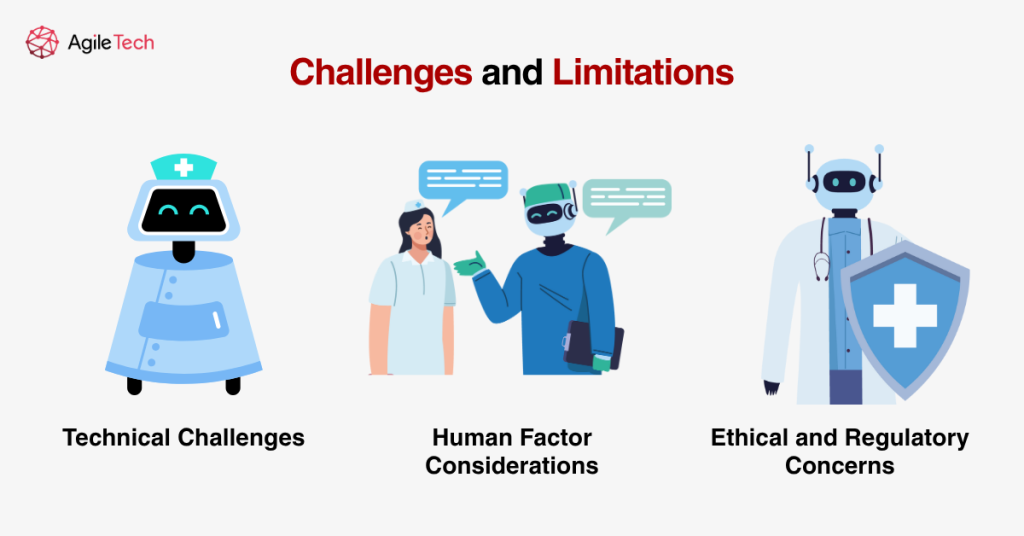
5.1. Technical Challenges
Data quality issues represent the most fundamental technical challenge facing healthcare AI automation. Healthcare data is often incomplete, inconsistent, or recorded in formats that are difficult for AI systems to process. Electronic health records contain significant amounts of unstructured text, inconsistent terminology, and missing information that can lead to inaccurate AI predictions.
Integration complexity arises from the diversity of healthcare information systems and the lack of standardized data formats. Healthcare organizations typically use dozens of different software systems that don’t communicate effectively with each other. Implementing automation in healthcare often requires extensive custom integration work that is expensive and time-consuming.
Algorithm bias can perpetuate or amplify existing healthcare disparities if AI systems are trained on data that doesn’t represent diverse patient populations. Many AI systems perform well for majority populations but show reduced accuracy for minorities, women, or elderly patients. This bias can lead to misdiagnosis or inappropriate treatment recommendations for vulnerable populations.
Scalability challenges emerge when successful pilot programs must be expanded to handle thousands of patients across multiple healthcare facilities. AI systems that work well in controlled environments may struggle with the variability and complexity of real-world healthcare operations.
Maintenance and updates require ongoing technical expertise that many healthcare organizations lack. AI and automation in healthcare systems need continuous monitoring, periodic retraining, and regular updates to maintain accuracy and relevance. The rapid pace of medical knowledge advancement means that automated systems can become outdated quickly without proper maintenance.
5.2. Ethical and Regulatory Concerns
Patient privacy protection becomes more complex when AI systems analyze vast amounts of personal health information. While AI can improve care coordination and population health management, it also creates new risks for data breaches and unauthorized access to sensitive information. Healthcare organizations must balance the benefits of data sharing with the need to protect patient confidentiality.
Regulatory compliance challenges arise from the evolving nature of healthcare AI regulations. The FDA has approved numerous AI-powered medical devices, but the regulatory framework continues to evolve as technology advances. Healthcare providers must navigate complex approval processes while ensuring that AI implementations meet all applicable regulations.
Liability and accountability questions become complex when AI systems contribute to medical decision-making. If an AI system makes an incorrect recommendation that leads to patient harm, determining responsibility between the AI vendor, healthcare provider, and individual clinician can be challenging. This uncertainty creates legal risks that many healthcare organizations are reluctant to accept.
Informed consent requirements may need modification when AI systems are involved in patient care. Patients have the right to understand how their care decisions are made, but the complexity of AI algorithms makes it difficult to provide meaningful explanations of automated recommendations.
Transparency and explainability concerns arise because many AI systems operate as “black boxes” that provide recommendations without clear explanations of their reasoning. Healthcare providers need to understand why AI systems make specific recommendations to maintain clinical oversight and patient trust.
5.3. Human Factor Considerations
Clinician resistance often stems from concerns about job displacement, loss of clinical autonomy, or skepticism about AI accuracy. Successful AI implementations require extensive change management programs that address these concerns through education, training, and gradual implementation approaches.
Training requirements are substantial because healthcare workers must learn to interpret AI recommendations, understand system limitations, and maintain clinical skills when AI assistance is not available. This training represents a significant time and cost investment for healthcare organizations.
Over-reliance risks emerge when clinicians become too dependent on AI recommendations and lose critical thinking skills or clinical intuition. Maintaining the balance between AI assistance and human judgment requires ongoing attention and training.
Workflow disruption can occur when automation in healthcare systems don’t integrate smoothly with existing clinical processes. Healthcare workers may resist systems that require additional steps, slow down familiar processes, or provide information in formats that don’t match clinical workflows.
Technology fatigue affects healthcare workers who are already overwhelmed by electronic health records, communication systems, and other digital tools. Adding AI automation to an already complex technology environment can increase stress and reduce job satisfaction if not implemented thoughtfully.
6. Conclusion
AI automation in healthcare has evolved from experimental technology to essential infrastructure that is quietly transforming patient care, operational efficiency, and medical decision-making. The most successful implementations focus on solving immediate, practical problems through business process automation in healthcare, clinical decision support, and diagnostic assistance.
While challenges exist around technical integration and ethical considerations, these are manageable with proper planning and resources. Looking forward, automation in healthcare will continue evolving toward integrated platforms that coordinate care across the entire healthcare ecosystem.
The healthcare industry stands at a pivotal moment where the question is no longer whether to implement AI and automation in healthcare, but how to do it effectively in service of better patient outcomes.
